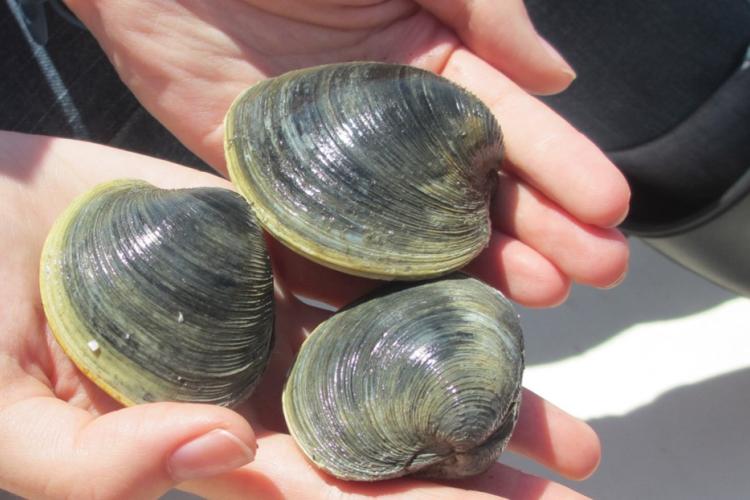Save the quahogs!
By Rob Smith / ecoRI News staff
More transplants, more monitoring, and maybe even more
nitrogen in Narragansett Bay.
Credit: NOAA Fisheries/Julie Rose
Those are the main recommendations coming from a joint
legislative study commission investigating the decline of quahog catches in the
bay.
The commission, which has been meeting every month since
September, concluded its work during a final meeting on April 30, when it
approved a final report outlining its findings and recommendations on what to
do about them.
The decline of the quahog in Narragansett Bay has been
something of an ontological mystery for quahoggers and bay scientists during
the past two decades. The number of quahogs caught wild in bay waters has been
slowly declining for much of the 20th century, not counting a pair of peaks in
the 1960s and ’80s.
According to data from the Department of Environmental
Management, quahog landings have declined to levels between 400,000 and 1
million pounds a year since 2005, a dip similar to those seen in other New
England states. The numbers are a far cry from the more than 4 million pounds
of quahogs caught at the 1982 peak.
Among the recommendations the commission voted to
approve: boosting the state’s quahog transplant program to increase shellfish
hatchlings in the bay; establishing more spawning sanctuaries; and developing a
long-term restoration plan for the upper bay.
What’s not among the recommendations? Pledges to add more nitrogen in the bay to offset the dozen wastewater treatment plants. Heavily advocated for by shellfisherman, who view a direct link between the cleanup of the bay and the decline in quahog landings, adding nitrogen was opposed by other commission members, including DEM.
The state agency noted that it may not fix the decline in quahogs, and the state did not have enough data to pinpoint a number that would increase quahogs and satisfy the federal requirements in the federal Clean Water Act.
“We’re permit writers,” said David Borkman, a DEM
environmental scientist who represented the department on the study commission.
“At the end of the day we have to come up with a number.”
Borkman said there was not enough available data to make
a proper determination whether increasing nitrogen would help, but said the
department was open to creating a plan to study the issue.
Jim Boyd, a shellfisherman who up until a few years ago
was the deputy chief for the Coastal Resources Management Council, acknowledged
the difficulties of increasing nitrogen in the bay.
“We recognize with the department’s strong objection, the
technical feasibility issues for the Narragansett Bay Commission, that it’s
unlikely that would happen, but we’re still supporting it because it is
feasible, and it should be explored,” Boyd said.
An industry that once boasted a vibrant local economy, with hundreds of quahoggers harvesting clams out of the bay, has now been whittled down to a couple dozen fishers, many of them slowly aging out of the industry.
Representatives of the shellfishing industry on the study commission
expressed concerns that quahogging as a vocation would vanish just as the
quahogs are vanishing from the bay.
Commission members have, at times, clashed during the
past eight months over why quahogs have declined in the bay, and what the state
should do about it.
For quahoggers and shellfishermen, it’s a case of
correlation very much equaling causation. The state’s shellfishermen have
heavily advocated that the decrease in nitrogen from the state’s wastewater
treatment plants is a key cause of the decline in quahogs over the past 20
years.
DEM has spent much of the past 21 years getting the dozen or so wastewater treatment plants that discharge in or around Narragansett Bay to reduce the amount of nitrogen associated with their discharges under the authority of the Clean Water Act, which dictates public waters must be fishable and swimmable.
The inciting action to crack down on the treatment plants for
DEM was the hypoxic event in Greenwich Bay in 2003, when a million menhaden
died in the bay’s waters due to a lack of dissolved oxygen in the water.
Unfortunately, an easy answer as to declining quahogs is
still unknown, as nitrogen isn’t the only thing that’s changed in Narragansett
Bay. The impacts of climate change have seen waters in the bay increase over
time, and as the bay has been cleaned up, quahogs’ natural predators are moving
into waters that were previously vacant of most predators.
Commission chairs Rep. Joseph Solomon, D-Warwick, and
Sen. Alana DiMario, D-North Kingstown, pledged to include more resources for
DEM’s quahog transplant program within the state budget next month.
“We’re going to be in direct contact with the House and
Senate Finance committees to include that in the budget,” Solomon told the
commission. “It’s a very necessary thing to keep the industry going.”